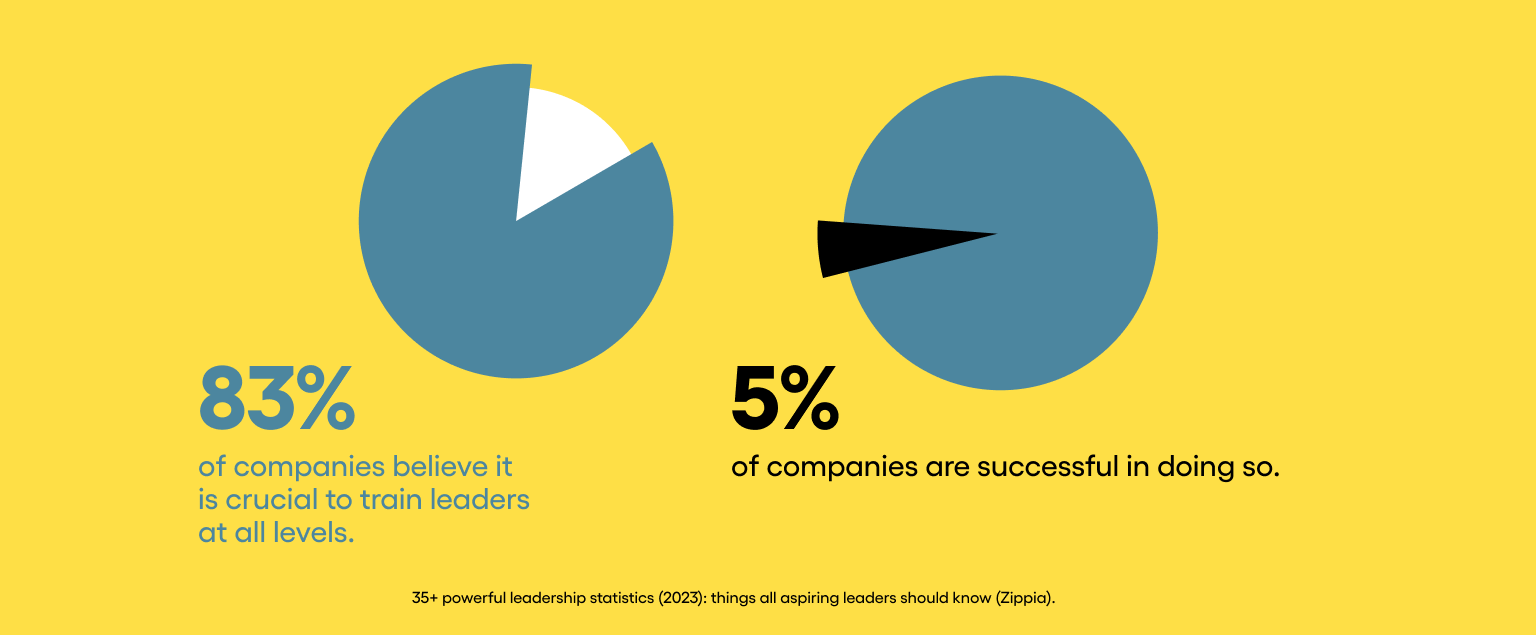Today’s leaders operate in a complex, volatile and uncertain terrain. Between climate change, widespread austerity, wars, and major technological developments, the permacrisis context has led to the emergence of resilience as a crucial quality for leaders, symbolizing their ability to navigate storms with agility, efficiency and optimism.
This more flexible management approach, coupled with an indispensable capacity for adaptation and positive stress management, is central to the distinction between organizational leadership and traditional leadership within contemporary structures and offers new perspectives on corporate success and sustainability in the current environment.
Discover the 7 essential steps to building resilient organizational leaders within your organization.
Step 1: Assessing Current Leadership Resilience
“A manager’s role goes far beyond supervision: it influences 70% of a team’s commitment”: expectations of managers have changed substantially in the last decade, and this new generation of managers, true catalysts of change, are earning the role of Leaders with a capital L. Far from being a detail, this capital letter underlines the differences between organizational Leadership and traditional management.
This new approach is not yet evident, however: 82% of HR leaders share that their managers aren’t equipped to lead change, and while 83% of companies believe it is crucial to train leaders at all levels, only 5% of them succeed in doing so. So how do we ensure that we have the right people in management positions?
In their report, Gartner recommends exposing aspiring managers to the more difficult aspects of the role as early as possible, but also normalizing the act of opting out of management through self-discovery. And while training helps equip them, resilience is first and foremost a human affair: “Organizational resilience is not a conventional skill. It stems from an inner attitude, a mindset”. It therefore seems essential to be able to examine the behavior of future leaders, as technical expertise is no longer the only prerequisite for these roles.
SuccessFinder’s behavioral assessment, in particular, enables you to assess the level of self-awareness your leaders have, and by extension, their capacity for resilience. A manager who excels in both internal self-awareness (knowing his or her strengths and weaknesses well) and external self-awareness (being lucid about how others perceive him or her) will most certainly have a high capacity for resilience, and will be able to lead the organization into the future while preserving their well-being: “Letting managers self-discover their fit for role increases their likelihood of finding their jobs manageable by 2.3x”.
Step 2: Establishing a Culture of Open Communication
To act as catalysts for change, organizational leaders must be able to communicate their vision, coach their teams and enable them to share ideas, concerns and feedback – in short: establish a culture of open communication.
When accompanied by clear, transparent strategies, it goes a long way towards strengthening operational resilience: encouraging constant dialogue, fostering diversity of opinion and establishing communication channels in which information flows freely, top-down and vice-versa, are all effective approaches as they build trust, stimulate innovation and thus prepare the company to meet challenges with agility.
Step 3: Encouraging Adaptive Thinking
Cultivating adaptive thinking in managers, at all levels, is essential for successfully navigating uncertain environments: indeed, a wealth of research indicates that teams that know how to demonstrate flexibility and adaptability show more creativity and innovation – two essential elements for transforming challenges into potential opportunities, and thus demonstrating resilience. According to Adam Grant, Professor at Wharton University, a management expert and specialist in adaptive thinking: “In a turbulent world, of all the cognitive skills you need, thinking things through and revising your judgments are among the most important”.
This means, among other things, understanding and making optimal and appropriate use of individual skills within the team, and providing flexibility and support according to the unique needs of each team member. Here again, open communication plays a key role, as it helps to get to the bottom of everyone’s expectations and needs. To ensure that this objective is achieved, it should be accompanied by the promotion of continuous learning and innovation.
Step 4: Implementing Stress Management Techniques
According to Gartner, an average manager has 51% more responsibilities than they can effectively manage. This is a worrying finding, as an exhausted leader is unlikely to be resilient, regardless of his or her skills. The impact on the team can be severe, with tension, unrealistic demands and unfair treatment leading to conflict.
Yet it is in times of turmoil and uncertainty that the need for strong, inspiring and resilient leadership is most keenly felt since it is often in the face of adversity that resilience emerges.
There is thus an urgent need to support leaders, in particular by helping them to understand their role (orchestrating collective success vs. being solely responsible for achieving objectives) and to spare their ability to manage negative thoughts and make the right decisions.
In addition to promoting healthy lifestyle habits and encouraging managers to take care of their cognitive hygiene, organizations and leaders can also use their psychometric test results to better understand their stress triggers, their natural (and perhaps unconscious) way of responding to them, and to develop more optimal coping mechanisms for their stress management. Finally, within the company, it’s a question of getting to know each other better and creating a climate of trust to normalize the request for help and recognize that burnout is not an individual responsibility, but a shared one.
Step 5: Building a Supportive Network
Research has shown that social support for the manager can moderate the tension and stress felt by his or her team – an impact that is even stronger in contexts of instability and change. Breaking down barriers is thus key to the quest for resilience, fostering collaboration, collective intelligence and knowledge transfer (mentoring, training).
While a solid support network plays a decisive role in maintaining managers’ mental health, it also enables them to stay informed, and therefore anticipate and proactively adapt to change before it becomes disruptive.
Step 6: Celebrating and Learning from Failures
For resilient leaders, failure represents a valuable learning experience, and it is central to their mindset: so they fearlessly encourage their teams to innovate and take risks. The culture of learning, of sharing stories of how teams have faced significant challenges and grown from them, is an integral part of the resilient leadership style.
By seeing change as an opportunity for growth rather than an obstacle, resilient managers create an environment where growth (professional and personal) is valued, and new ideas are encouraged.
However, this requires laying out the path and offering support and resources to get through the more intense phases of change. Finally, communication is essential here too: sharing the reasons behind any change is crucial to fostering its acceptance, its purpose and its benefits. Giving your team an overview and a context helps them to invest positively in the process.
Step 7: Providing Continuous Learning Opportunities
Organizational leaders know all too well: a professionally fulfilled team will be a high-performing one, so it is essential to offer them development opportunities. Similarly, a resilient company will make sure to offer its managers continuous training, so that they constantly hone the key qualities of Organizational Leadership: vision, strategic thinking, emotional intelligence, communication, et cetera.
Far from being a mere trend, continuous learning contributes to empowering teams and instilling the desired state of mind within the organization: greater adaptability, creation of agile and responsive forces, collaborative culture and development of collective intelligence, etc. This is a real strategic move towards success.
To assess current skills and areas for improvement, a tool like SuccessFinder can be very useful indeed. It will enable you to align your analysis results with your company’s growth and organizational leadership development objectives.
In a permacrisis world, organizational leaders must cultivate resilience to thrive. Traditional management methods are too rigid and no longer align with business realities. The time has come for questioning, agility, humility, humanity and acceptance of the global socio-economic context, to ride the waves rather than fight against them. As Winston Churchill said: “Success is not final. Failure is not fatal. It is the courage to continue that counts.” And therein lies the strength in resilience.

Discover the key behaviors of leaders. Dive into our ladder of leadership model.





